Tesco Case Study: Training and Development's Impact on Retention
VerifiedAdded on 2020/07/23
|38
|11342
|883
Report
AI Summary
This report presents a comprehensive analysis of the impact of training and development on employee retention, focusing on a case study of Tesco, Pinner. The research investigates the importance of training and development in enhancing employee skills, knowledge, and competencies, crucial for reducing turnover and increasing satisfaction. The study uses a mixed-method approach, including questionnaires distributed to Tesco managers and secondary data analysis. It explores the relationship between training and employee retention, the effects of training on employee satisfaction, and recommends strategies to improve retention rates. The report includes an introduction outlining the research background, rationale, and objectives, followed by a literature review establishing the theoretical framework. The methodology chapter details the research philosophy, approach, design, and data collection methods. The findings are presented in the data analysis section, and the conclusion and recommendations chapter summarizes the key insights and suggests practical improvements for Tesco's training and development programs to boost employee retention. The report aims to provide valuable insights into the effectiveness of training and development initiatives within the retail sector.
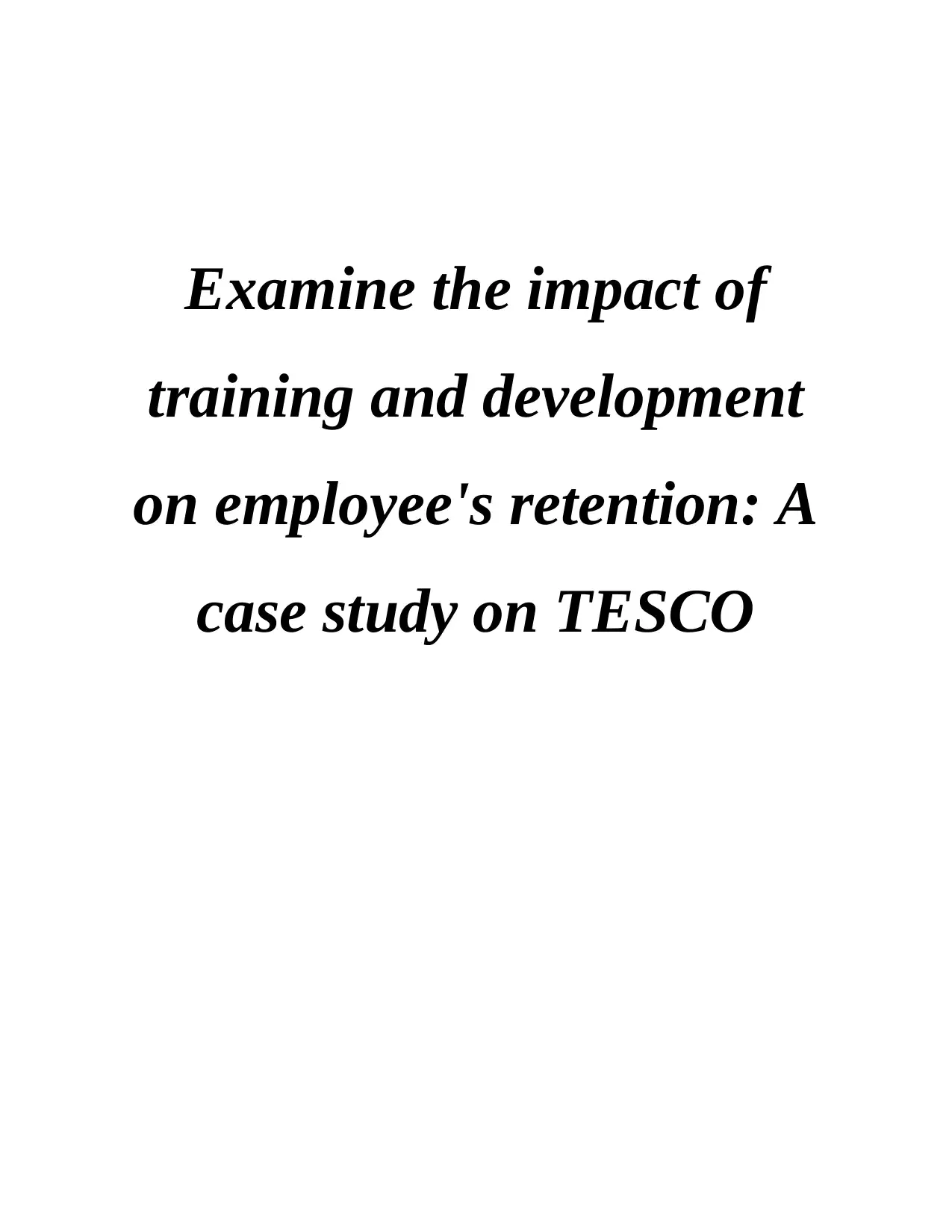
Examine the impact of
training and development
on employee's retention: A
case study on TESCO
training and development
on employee's retention: A
case study on TESCO
Paraphrase This Document
Need a fresh take? Get an instant paraphrase of this document with our AI Paraphraser
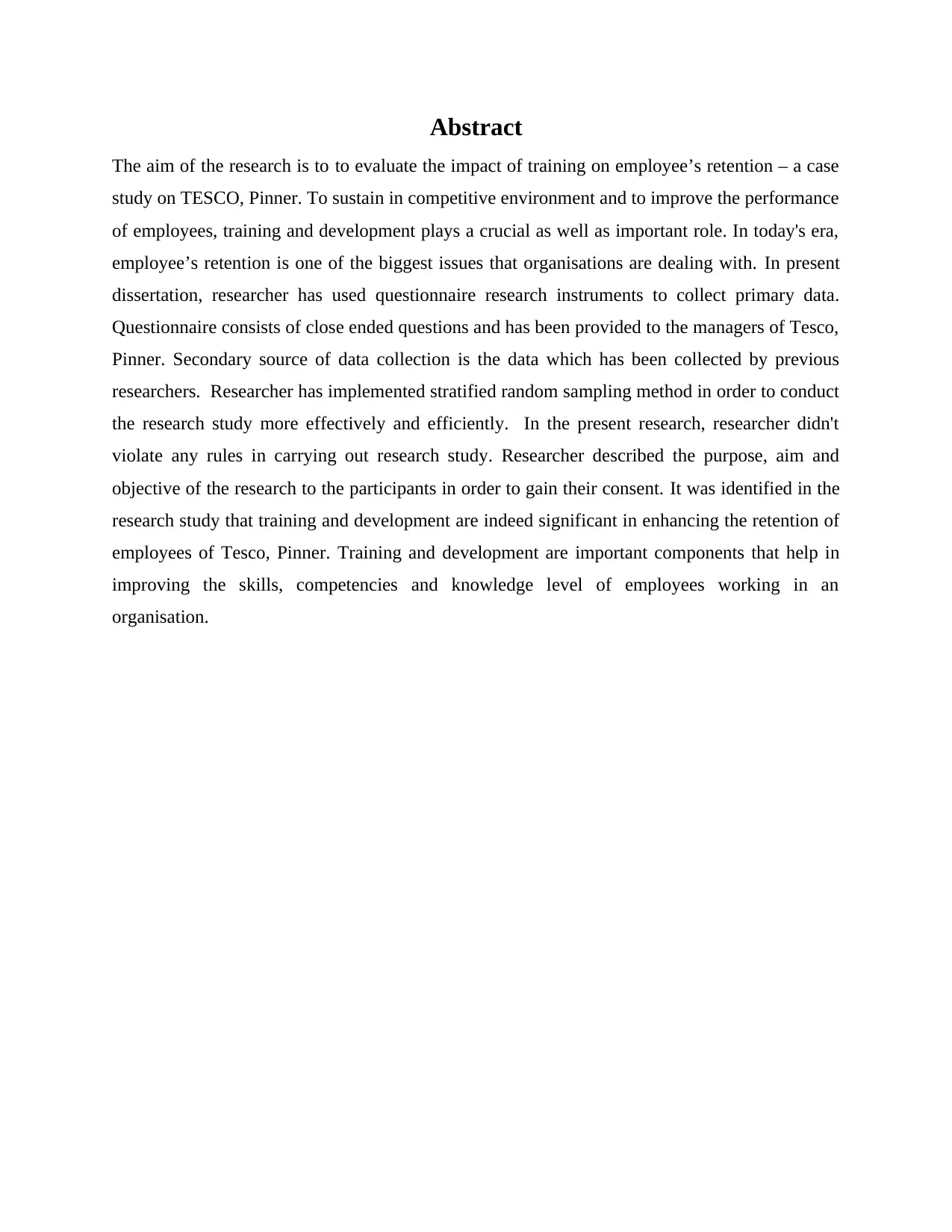
Abstract
The aim of the research is to to evaluate the impact of training on employee’s retention – a case
study on TESCO, Pinner. To sustain in competitive environment and to improve the performance
of employees, training and development plays a crucial as well as important role. In today's era,
employee’s retention is one of the biggest issues that organisations are dealing with. In present
dissertation, researcher has used questionnaire research instruments to collect primary data.
Questionnaire consists of close ended questions and has been provided to the managers of Tesco,
Pinner. Secondary source of data collection is the data which has been collected by previous
researchers. Researcher has implemented stratified random sampling method in order to conduct
the research study more effectively and efficiently. In the present research, researcher didn't
violate any rules in carrying out research study. Researcher described the purpose, aim and
objective of the research to the participants in order to gain their consent. It was identified in the
research study that training and development are indeed significant in enhancing the retention of
employees of Tesco, Pinner. Training and development are important components that help in
improving the skills, competencies and knowledge level of employees working in an
organisation.
The aim of the research is to to evaluate the impact of training on employee’s retention – a case
study on TESCO, Pinner. To sustain in competitive environment and to improve the performance
of employees, training and development plays a crucial as well as important role. In today's era,
employee’s retention is one of the biggest issues that organisations are dealing with. In present
dissertation, researcher has used questionnaire research instruments to collect primary data.
Questionnaire consists of close ended questions and has been provided to the managers of Tesco,
Pinner. Secondary source of data collection is the data which has been collected by previous
researchers. Researcher has implemented stratified random sampling method in order to conduct
the research study more effectively and efficiently. In the present research, researcher didn't
violate any rules in carrying out research study. Researcher described the purpose, aim and
objective of the research to the participants in order to gain their consent. It was identified in the
research study that training and development are indeed significant in enhancing the retention of
employees of Tesco, Pinner. Training and development are important components that help in
improving the skills, competencies and knowledge level of employees working in an
organisation.
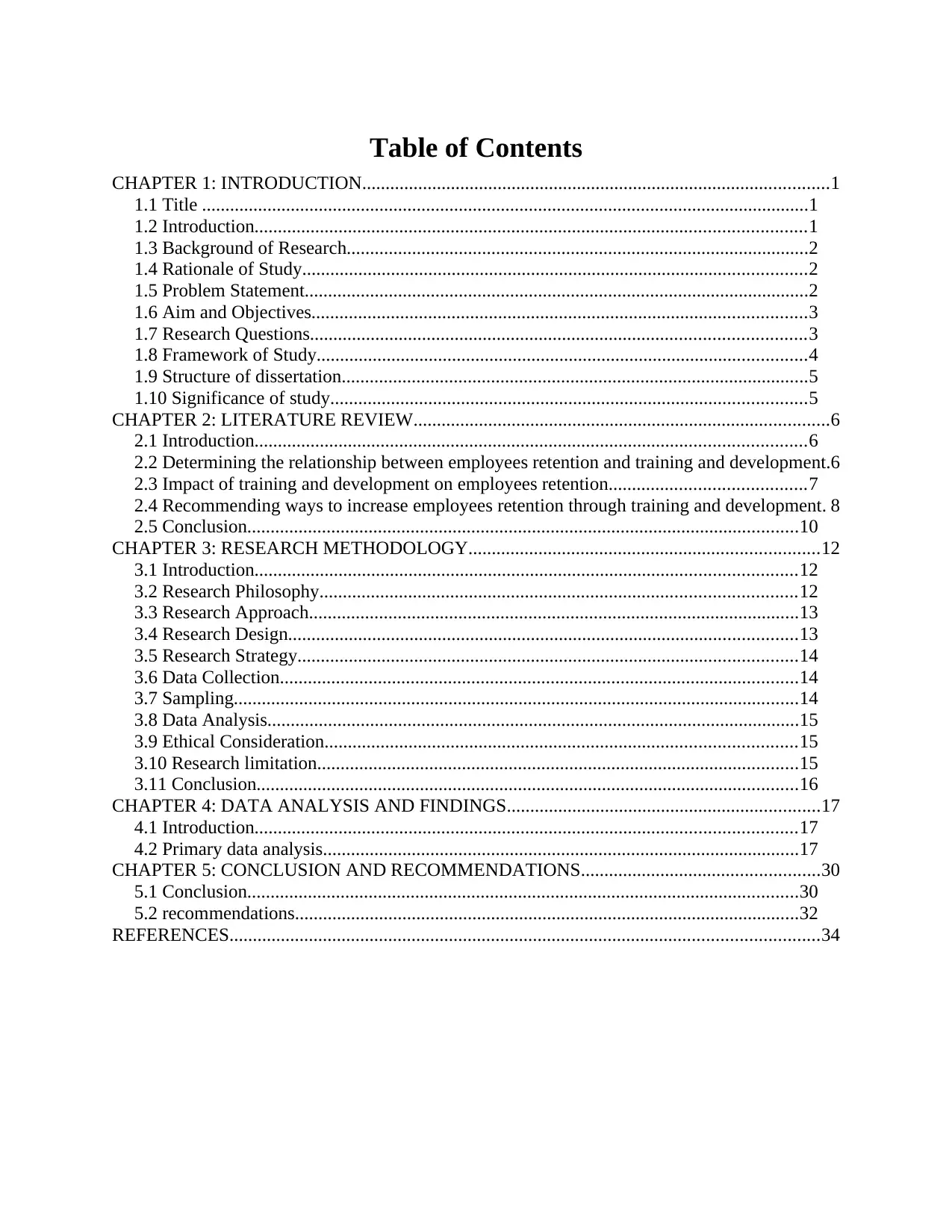
Table of Contents
CHAPTER 1: INTRODUCTION....................................................................................................1
1.1 Title ..................................................................................................................................1
1.2 Introduction......................................................................................................................1
1.3 Background of Research...................................................................................................2
1.4 Rationale of Study............................................................................................................2
1.5 Problem Statement............................................................................................................2
1.6 Aim and Objectives..........................................................................................................3
1.7 Research Questions..........................................................................................................3
1.8 Framework of Study.........................................................................................................4
1.9 Structure of dissertation....................................................................................................5
1.10 Significance of study......................................................................................................5
CHAPTER 2: LITERATURE REVIEW.........................................................................................6
2.1 Introduction......................................................................................................................6
2.2 Determining the relationship between employees retention and training and development.6
2.3 Impact of training and development on employees retention..........................................7
2.4 Recommending ways to increase employees retention through training and development. 8
2.5 Conclusion......................................................................................................................10
CHAPTER 3: RESEARCH METHODOLOGY...........................................................................12
3.1 Introduction....................................................................................................................12
3.2 Research Philosophy......................................................................................................12
3.3 Research Approach.........................................................................................................13
3.4 Research Design.............................................................................................................13
3.5 Research Strategy...........................................................................................................14
3.6 Data Collection...............................................................................................................14
3.7 Sampling.........................................................................................................................14
3.8 Data Analysis..................................................................................................................15
3.9 Ethical Consideration.....................................................................................................15
3.10 Research limitation.......................................................................................................15
3.11 Conclusion....................................................................................................................16
CHAPTER 4: DATA ANALYSIS AND FINDINGS...................................................................17
4.1 Introduction....................................................................................................................17
4.2 Primary data analysis......................................................................................................17
CHAPTER 5: CONCLUSION AND RECOMMENDATIONS...................................................30
5.1 Conclusion......................................................................................................................30
5.2 recommendations............................................................................................................32
REFERENCES..............................................................................................................................34
CHAPTER 1: INTRODUCTION....................................................................................................1
1.1 Title ..................................................................................................................................1
1.2 Introduction......................................................................................................................1
1.3 Background of Research...................................................................................................2
1.4 Rationale of Study............................................................................................................2
1.5 Problem Statement............................................................................................................2
1.6 Aim and Objectives..........................................................................................................3
1.7 Research Questions..........................................................................................................3
1.8 Framework of Study.........................................................................................................4
1.9 Structure of dissertation....................................................................................................5
1.10 Significance of study......................................................................................................5
CHAPTER 2: LITERATURE REVIEW.........................................................................................6
2.1 Introduction......................................................................................................................6
2.2 Determining the relationship between employees retention and training and development.6
2.3 Impact of training and development on employees retention..........................................7
2.4 Recommending ways to increase employees retention through training and development. 8
2.5 Conclusion......................................................................................................................10
CHAPTER 3: RESEARCH METHODOLOGY...........................................................................12
3.1 Introduction....................................................................................................................12
3.2 Research Philosophy......................................................................................................12
3.3 Research Approach.........................................................................................................13
3.4 Research Design.............................................................................................................13
3.5 Research Strategy...........................................................................................................14
3.6 Data Collection...............................................................................................................14
3.7 Sampling.........................................................................................................................14
3.8 Data Analysis..................................................................................................................15
3.9 Ethical Consideration.....................................................................................................15
3.10 Research limitation.......................................................................................................15
3.11 Conclusion....................................................................................................................16
CHAPTER 4: DATA ANALYSIS AND FINDINGS...................................................................17
4.1 Introduction....................................................................................................................17
4.2 Primary data analysis......................................................................................................17
CHAPTER 5: CONCLUSION AND RECOMMENDATIONS...................................................30
5.1 Conclusion......................................................................................................................30
5.2 recommendations............................................................................................................32
REFERENCES..............................................................................................................................34
⊘ This is a preview!⊘
Do you want full access?
Subscribe today to unlock all pages.

Trusted by 1+ million students worldwide
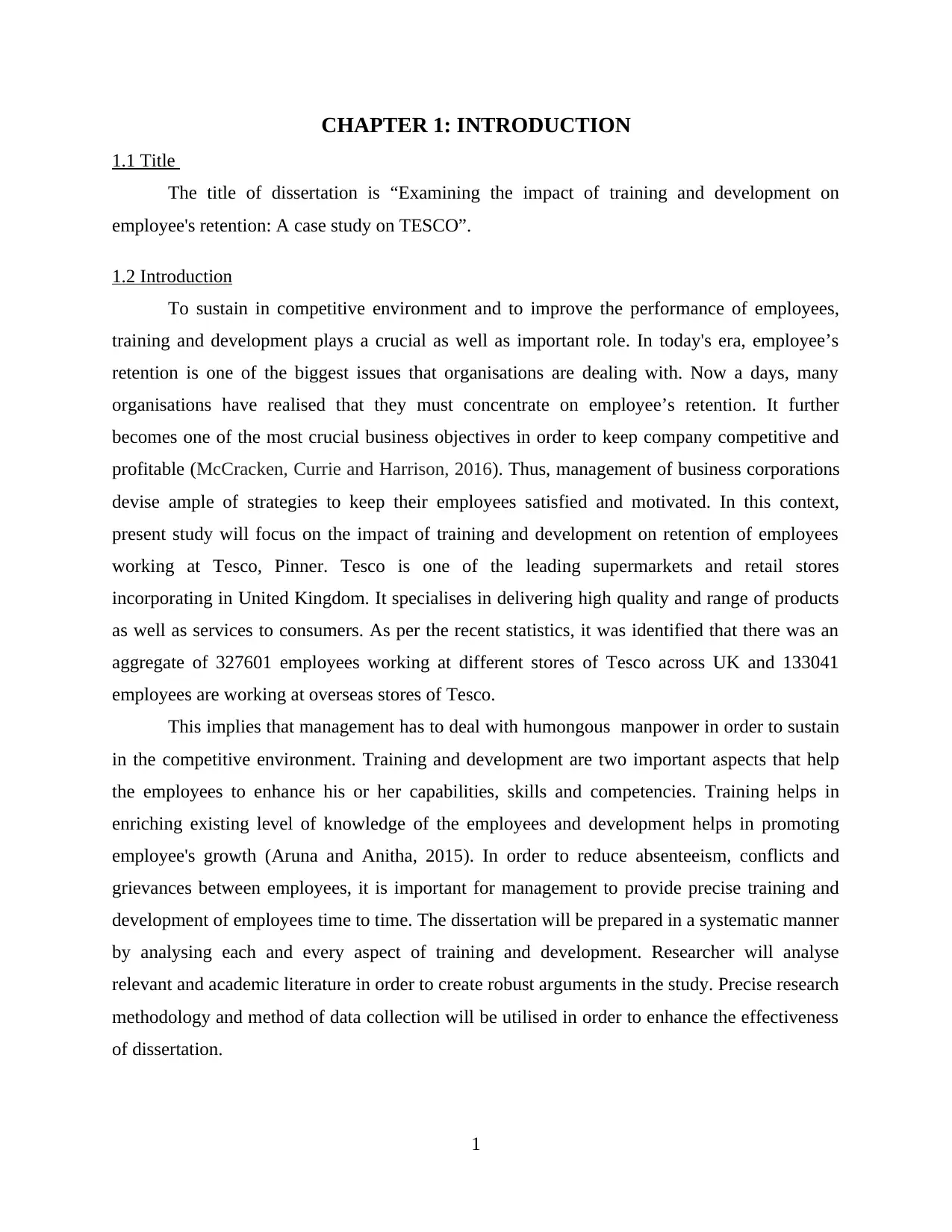
CHAPTER 1: INTRODUCTION
1.1 Title
The title of dissertation is “Examining the impact of training and development on
employee's retention: A case study on TESCO”.
1.2 Introduction
To sustain in competitive environment and to improve the performance of employees,
training and development plays a crucial as well as important role. In today's era, employee’s
retention is one of the biggest issues that organisations are dealing with. Now a days, many
organisations have realised that they must concentrate on employee’s retention. It further
becomes one of the most crucial business objectives in order to keep company competitive and
profitable (McCracken, Currie and Harrison, 2016). Thus, management of business corporations
devise ample of strategies to keep their employees satisfied and motivated. In this context,
present study will focus on the impact of training and development on retention of employees
working at Tesco, Pinner. Tesco is one of the leading supermarkets and retail stores
incorporating in United Kingdom. It specialises in delivering high quality and range of products
as well as services to consumers. As per the recent statistics, it was identified that there was an
aggregate of 327601 employees working at different stores of Tesco across UK and 133041
employees are working at overseas stores of Tesco.
This implies that management has to deal with humongous manpower in order to sustain
in the competitive environment. Training and development are two important aspects that help
the employees to enhance his or her capabilities, skills and competencies. Training helps in
enriching existing level of knowledge of the employees and development helps in promoting
employee's growth (Aruna and Anitha, 2015). In order to reduce absenteeism, conflicts and
grievances between employees, it is important for management to provide precise training and
development of employees time to time. The dissertation will be prepared in a systematic manner
by analysing each and every aspect of training and development. Researcher will analyse
relevant and academic literature in order to create robust arguments in the study. Precise research
methodology and method of data collection will be utilised in order to enhance the effectiveness
of dissertation.
1
1.1 Title
The title of dissertation is “Examining the impact of training and development on
employee's retention: A case study on TESCO”.
1.2 Introduction
To sustain in competitive environment and to improve the performance of employees,
training and development plays a crucial as well as important role. In today's era, employee’s
retention is one of the biggest issues that organisations are dealing with. Now a days, many
organisations have realised that they must concentrate on employee’s retention. It further
becomes one of the most crucial business objectives in order to keep company competitive and
profitable (McCracken, Currie and Harrison, 2016). Thus, management of business corporations
devise ample of strategies to keep their employees satisfied and motivated. In this context,
present study will focus on the impact of training and development on retention of employees
working at Tesco, Pinner. Tesco is one of the leading supermarkets and retail stores
incorporating in United Kingdom. It specialises in delivering high quality and range of products
as well as services to consumers. As per the recent statistics, it was identified that there was an
aggregate of 327601 employees working at different stores of Tesco across UK and 133041
employees are working at overseas stores of Tesco.
This implies that management has to deal with humongous manpower in order to sustain
in the competitive environment. Training and development are two important aspects that help
the employees to enhance his or her capabilities, skills and competencies. Training helps in
enriching existing level of knowledge of the employees and development helps in promoting
employee's growth (Aruna and Anitha, 2015). In order to reduce absenteeism, conflicts and
grievances between employees, it is important for management to provide precise training and
development of employees time to time. The dissertation will be prepared in a systematic manner
by analysing each and every aspect of training and development. Researcher will analyse
relevant and academic literature in order to create robust arguments in the study. Precise research
methodology and method of data collection will be utilised in order to enhance the effectiveness
of dissertation.
1
Paraphrase This Document
Need a fresh take? Get an instant paraphrase of this document with our AI Paraphraser
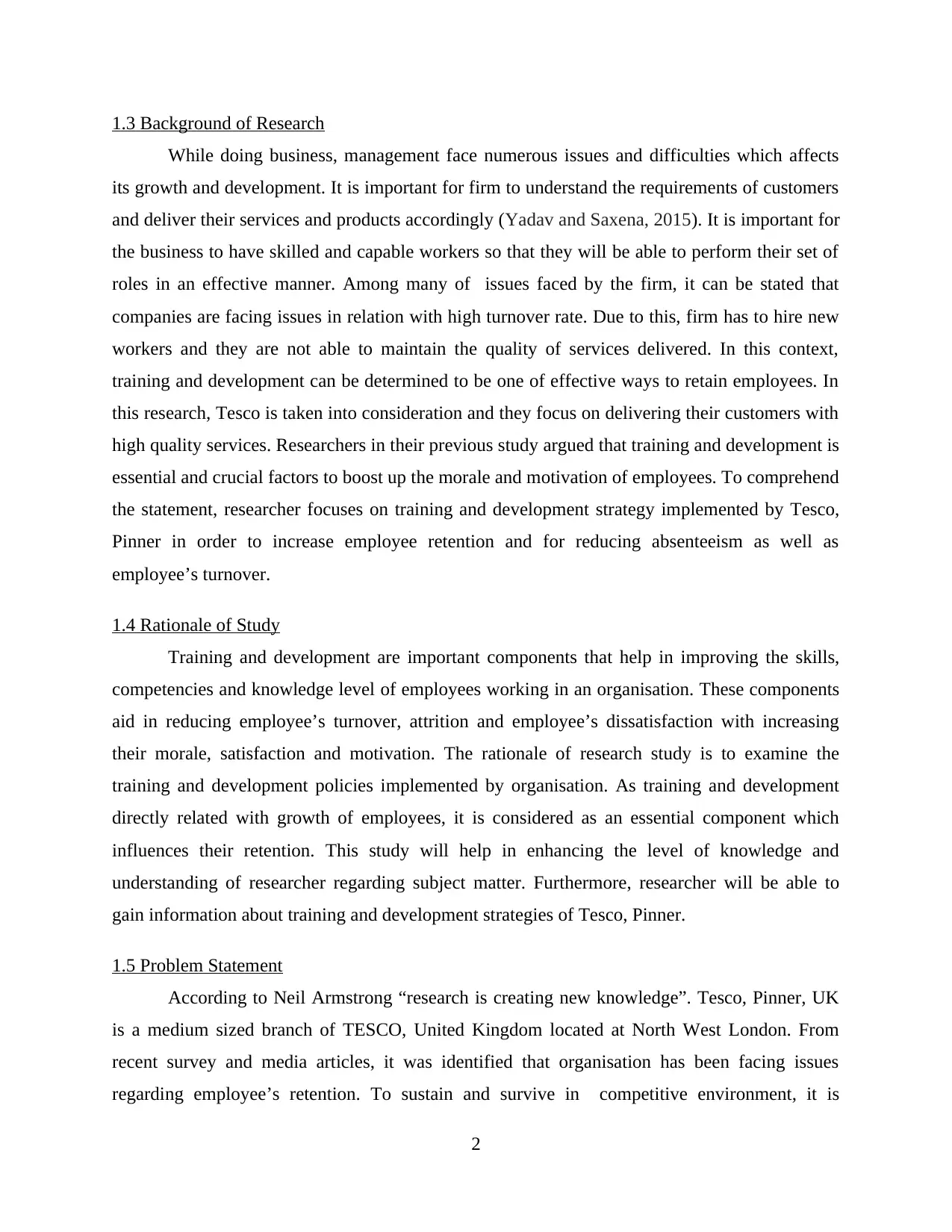
1.3 Background of Research
While doing business, management face numerous issues and difficulties which affects
its growth and development. It is important for firm to understand the requirements of customers
and deliver their services and products accordingly (Yadav and Saxena, 2015). It is important for
the business to have skilled and capable workers so that they will be able to perform their set of
roles in an effective manner. Among many of issues faced by the firm, it can be stated that
companies are facing issues in relation with high turnover rate. Due to this, firm has to hire new
workers and they are not able to maintain the quality of services delivered. In this context,
training and development can be determined to be one of effective ways to retain employees. In
this research, Tesco is taken into consideration and they focus on delivering their customers with
high quality services. Researchers in their previous study argued that training and development is
essential and crucial factors to boost up the morale and motivation of employees. To comprehend
the statement, researcher focuses on training and development strategy implemented by Tesco,
Pinner in order to increase employee retention and for reducing absenteeism as well as
employee’s turnover.
1.4 Rationale of Study
Training and development are important components that help in improving the skills,
competencies and knowledge level of employees working in an organisation. These components
aid in reducing employee’s turnover, attrition and employee’s dissatisfaction with increasing
their morale, satisfaction and motivation. The rationale of research study is to examine the
training and development policies implemented by organisation. As training and development
directly related with growth of employees, it is considered as an essential component which
influences their retention. This study will help in enhancing the level of knowledge and
understanding of researcher regarding subject matter. Furthermore, researcher will be able to
gain information about training and development strategies of Tesco, Pinner.
1.5 Problem Statement
According to Neil Armstrong “research is creating new knowledge”. Tesco, Pinner, UK
is a medium sized branch of TESCO, United Kingdom located at North West London. From
recent survey and media articles, it was identified that organisation has been facing issues
regarding employee’s retention. To sustain and survive in competitive environment, it is
2
While doing business, management face numerous issues and difficulties which affects
its growth and development. It is important for firm to understand the requirements of customers
and deliver their services and products accordingly (Yadav and Saxena, 2015). It is important for
the business to have skilled and capable workers so that they will be able to perform their set of
roles in an effective manner. Among many of issues faced by the firm, it can be stated that
companies are facing issues in relation with high turnover rate. Due to this, firm has to hire new
workers and they are not able to maintain the quality of services delivered. In this context,
training and development can be determined to be one of effective ways to retain employees. In
this research, Tesco is taken into consideration and they focus on delivering their customers with
high quality services. Researchers in their previous study argued that training and development is
essential and crucial factors to boost up the morale and motivation of employees. To comprehend
the statement, researcher focuses on training and development strategy implemented by Tesco,
Pinner in order to increase employee retention and for reducing absenteeism as well as
employee’s turnover.
1.4 Rationale of Study
Training and development are important components that help in improving the skills,
competencies and knowledge level of employees working in an organisation. These components
aid in reducing employee’s turnover, attrition and employee’s dissatisfaction with increasing
their morale, satisfaction and motivation. The rationale of research study is to examine the
training and development policies implemented by organisation. As training and development
directly related with growth of employees, it is considered as an essential component which
influences their retention. This study will help in enhancing the level of knowledge and
understanding of researcher regarding subject matter. Furthermore, researcher will be able to
gain information about training and development strategies of Tesco, Pinner.
1.5 Problem Statement
According to Neil Armstrong “research is creating new knowledge”. Tesco, Pinner, UK
is a medium sized branch of TESCO, United Kingdom located at North West London. From
recent survey and media articles, it was identified that organisation has been facing issues
regarding employee’s retention. To sustain and survive in competitive environment, it is
2
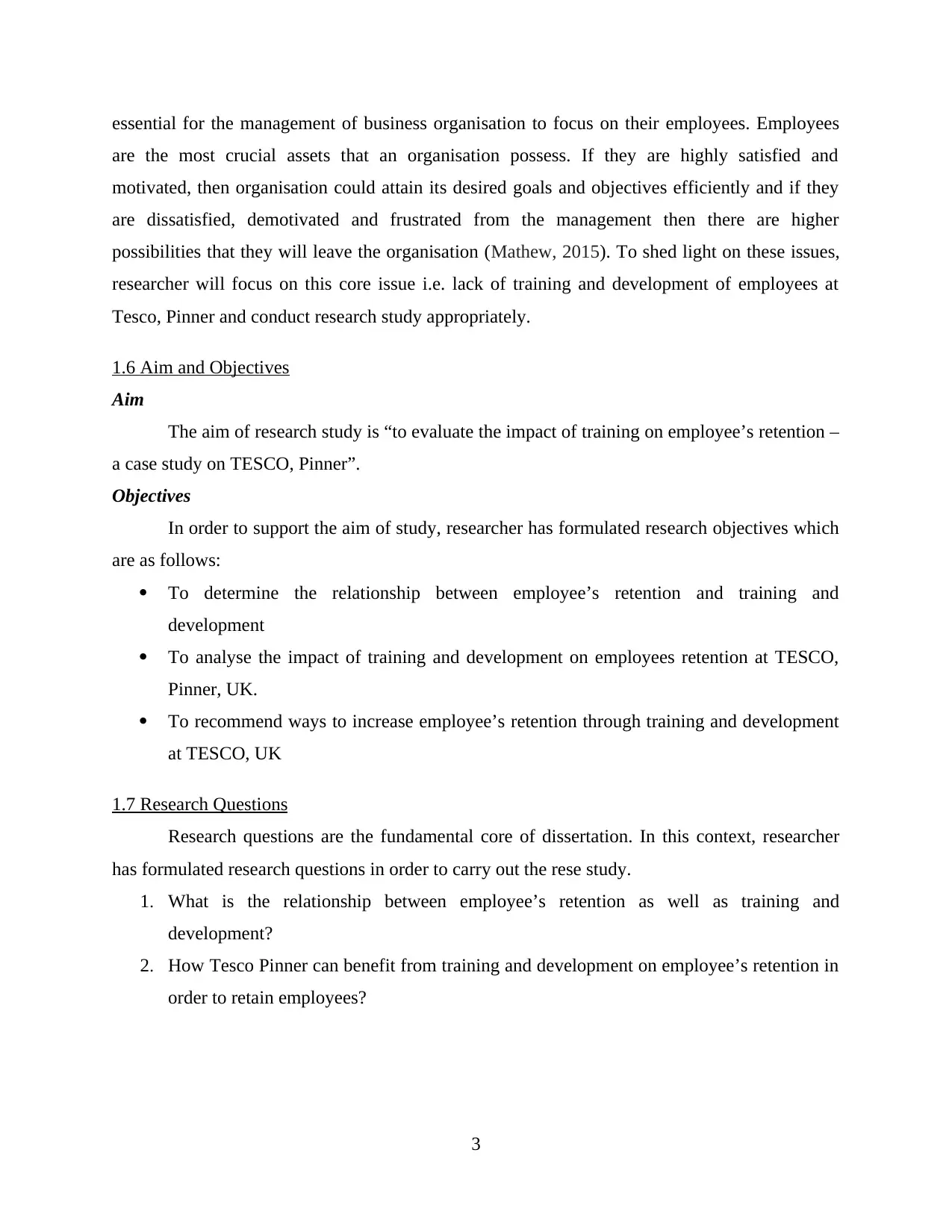
essential for the management of business organisation to focus on their employees. Employees
are the most crucial assets that an organisation possess. If they are highly satisfied and
motivated, then organisation could attain its desired goals and objectives efficiently and if they
are dissatisfied, demotivated and frustrated from the management then there are higher
possibilities that they will leave the organisation (Mathew, 2015). To shed light on these issues,
researcher will focus on this core issue i.e. lack of training and development of employees at
Tesco, Pinner and conduct research study appropriately.
1.6 Aim and Objectives
Aim
The aim of research study is “to evaluate the impact of training on employee’s retention –
a case study on TESCO, Pinner”.
Objectives
In order to support the aim of study, researcher has formulated research objectives which
are as follows:
To determine the relationship between employee’s retention and training and
development
To analyse the impact of training and development on employees retention at TESCO,
Pinner, UK.
To recommend ways to increase employee’s retention through training and development
at TESCO, UK
1.7 Research Questions
Research questions are the fundamental core of dissertation. In this context, researcher
has formulated research questions in order to carry out the rese study.
1. What is the relationship between employee’s retention as well as training and
development?
2. How Tesco Pinner can benefit from training and development on employee’s retention in
order to retain employees?
3
are the most crucial assets that an organisation possess. If they are highly satisfied and
motivated, then organisation could attain its desired goals and objectives efficiently and if they
are dissatisfied, demotivated and frustrated from the management then there are higher
possibilities that they will leave the organisation (Mathew, 2015). To shed light on these issues,
researcher will focus on this core issue i.e. lack of training and development of employees at
Tesco, Pinner and conduct research study appropriately.
1.6 Aim and Objectives
Aim
The aim of research study is “to evaluate the impact of training on employee’s retention –
a case study on TESCO, Pinner”.
Objectives
In order to support the aim of study, researcher has formulated research objectives which
are as follows:
To determine the relationship between employee’s retention and training and
development
To analyse the impact of training and development on employees retention at TESCO,
Pinner, UK.
To recommend ways to increase employee’s retention through training and development
at TESCO, UK
1.7 Research Questions
Research questions are the fundamental core of dissertation. In this context, researcher
has formulated research questions in order to carry out the rese study.
1. What is the relationship between employee’s retention as well as training and
development?
2. How Tesco Pinner can benefit from training and development on employee’s retention in
order to retain employees?
3
⊘ This is a preview!⊘
Do you want full access?
Subscribe today to unlock all pages.

Trusted by 1+ million students worldwide
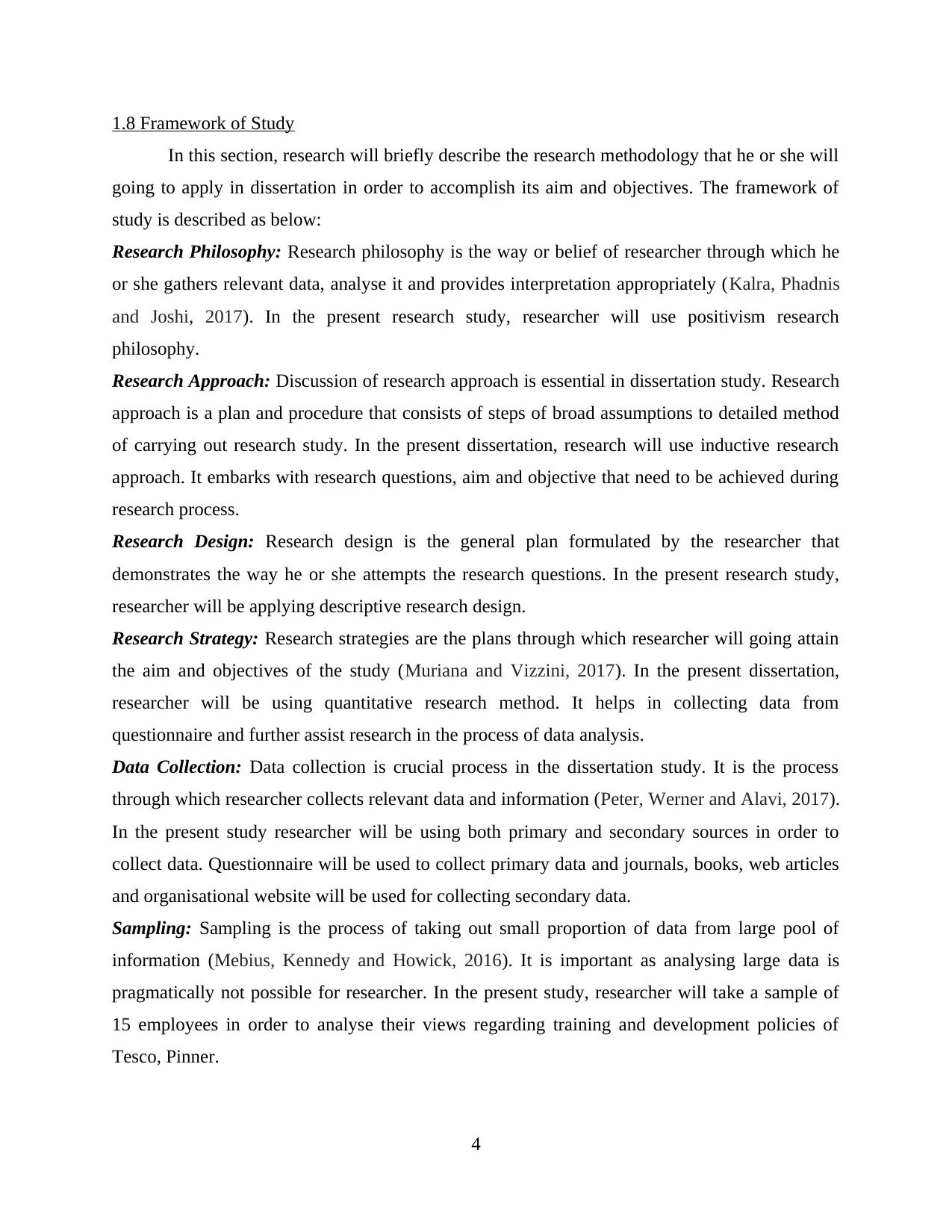
1.8 Framework of Study
In this section, research will briefly describe the research methodology that he or she will
going to apply in dissertation in order to accomplish its aim and objectives. The framework of
study is described as below:
Research Philosophy: Research philosophy is the way or belief of researcher through which he
or she gathers relevant data, analyse it and provides interpretation appropriately (Kalra, Phadnis
and Joshi, 2017). In the present research study, researcher will use positivism research
philosophy.
Research Approach: Discussion of research approach is essential in dissertation study. Research
approach is a plan and procedure that consists of steps of broad assumptions to detailed method
of carrying out research study. In the present dissertation, research will use inductive research
approach. It embarks with research questions, aim and objective that need to be achieved during
research process.
Research Design: Research design is the general plan formulated by the researcher that
demonstrates the way he or she attempts the research questions. In the present research study,
researcher will be applying descriptive research design.
Research Strategy: Research strategies are the plans through which researcher will going attain
the aim and objectives of the study (Muriana and Vizzini, 2017). In the present dissertation,
researcher will be using quantitative research method. It helps in collecting data from
questionnaire and further assist research in the process of data analysis.
Data Collection: Data collection is crucial process in the dissertation study. It is the process
through which researcher collects relevant data and information (Peter, Werner and Alavi, 2017).
In the present study researcher will be using both primary and secondary sources in order to
collect data. Questionnaire will be used to collect primary data and journals, books, web articles
and organisational website will be used for collecting secondary data.
Sampling: Sampling is the process of taking out small proportion of data from large pool of
information (Mebius, Kennedy and Howick, 2016). It is important as analysing large data is
pragmatically not possible for researcher. In the present study, researcher will take a sample of
15 employees in order to analyse their views regarding training and development policies of
Tesco, Pinner.
4
In this section, research will briefly describe the research methodology that he or she will
going to apply in dissertation in order to accomplish its aim and objectives. The framework of
study is described as below:
Research Philosophy: Research philosophy is the way or belief of researcher through which he
or she gathers relevant data, analyse it and provides interpretation appropriately (Kalra, Phadnis
and Joshi, 2017). In the present research study, researcher will use positivism research
philosophy.
Research Approach: Discussion of research approach is essential in dissertation study. Research
approach is a plan and procedure that consists of steps of broad assumptions to detailed method
of carrying out research study. In the present dissertation, research will use inductive research
approach. It embarks with research questions, aim and objective that need to be achieved during
research process.
Research Design: Research design is the general plan formulated by the researcher that
demonstrates the way he or she attempts the research questions. In the present research study,
researcher will be applying descriptive research design.
Research Strategy: Research strategies are the plans through which researcher will going attain
the aim and objectives of the study (Muriana and Vizzini, 2017). In the present dissertation,
researcher will be using quantitative research method. It helps in collecting data from
questionnaire and further assist research in the process of data analysis.
Data Collection: Data collection is crucial process in the dissertation study. It is the process
through which researcher collects relevant data and information (Peter, Werner and Alavi, 2017).
In the present study researcher will be using both primary and secondary sources in order to
collect data. Questionnaire will be used to collect primary data and journals, books, web articles
and organisational website will be used for collecting secondary data.
Sampling: Sampling is the process of taking out small proportion of data from large pool of
information (Mebius, Kennedy and Howick, 2016). It is important as analysing large data is
pragmatically not possible for researcher. In the present study, researcher will take a sample of
15 employees in order to analyse their views regarding training and development policies of
Tesco, Pinner.
4
Paraphrase This Document
Need a fresh take? Get an instant paraphrase of this document with our AI Paraphraser
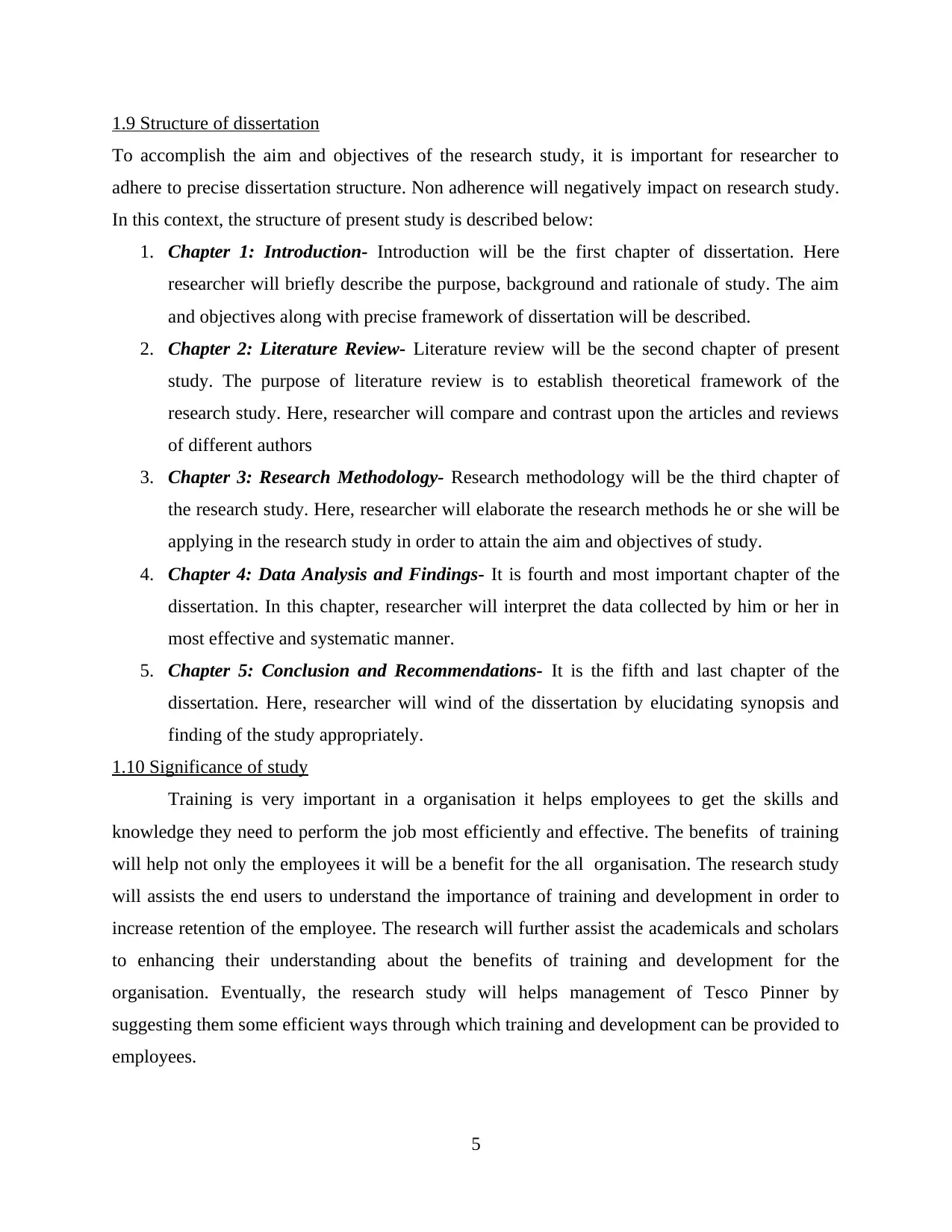
1.9 Structure of dissertation
To accomplish the aim and objectives of the research study, it is important for researcher to
adhere to precise dissertation structure. Non adherence will negatively impact on research study.
In this context, the structure of present study is described below:
1. Chapter 1: Introduction- Introduction will be the first chapter of dissertation. Here
researcher will briefly describe the purpose, background and rationale of study. The aim
and objectives along with precise framework of dissertation will be described.
2. Chapter 2: Literature Review- Literature review will be the second chapter of present
study. The purpose of literature review is to establish theoretical framework of the
research study. Here, researcher will compare and contrast upon the articles and reviews
of different authors
3. Chapter 3: Research Methodology- Research methodology will be the third chapter of
the research study. Here, researcher will elaborate the research methods he or she will be
applying in the research study in order to attain the aim and objectives of study.
4. Chapter 4: Data Analysis and Findings- It is fourth and most important chapter of the
dissertation. In this chapter, researcher will interpret the data collected by him or her in
most effective and systematic manner.
5. Chapter 5: Conclusion and Recommendations- It is the fifth and last chapter of the
dissertation. Here, researcher will wind of the dissertation by elucidating synopsis and
finding of the study appropriately.
1.10 Significance of study
Training is very important in a organisation it helps employees to get the skills and
knowledge they need to perform the job most efficiently and effective. The benefits of training
will help not only the employees it will be a benefit for the all organisation. The research study
will assists the end users to understand the importance of training and development in order to
increase retention of the employee. The research will further assist the academicals and scholars
to enhancing their understanding about the benefits of training and development for the
organisation. Eventually, the research study will helps management of Tesco Pinner by
suggesting them some efficient ways through which training and development can be provided to
employees.
5
To accomplish the aim and objectives of the research study, it is important for researcher to
adhere to precise dissertation structure. Non adherence will negatively impact on research study.
In this context, the structure of present study is described below:
1. Chapter 1: Introduction- Introduction will be the first chapter of dissertation. Here
researcher will briefly describe the purpose, background and rationale of study. The aim
and objectives along with precise framework of dissertation will be described.
2. Chapter 2: Literature Review- Literature review will be the second chapter of present
study. The purpose of literature review is to establish theoretical framework of the
research study. Here, researcher will compare and contrast upon the articles and reviews
of different authors
3. Chapter 3: Research Methodology- Research methodology will be the third chapter of
the research study. Here, researcher will elaborate the research methods he or she will be
applying in the research study in order to attain the aim and objectives of study.
4. Chapter 4: Data Analysis and Findings- It is fourth and most important chapter of the
dissertation. In this chapter, researcher will interpret the data collected by him or her in
most effective and systematic manner.
5. Chapter 5: Conclusion and Recommendations- It is the fifth and last chapter of the
dissertation. Here, researcher will wind of the dissertation by elucidating synopsis and
finding of the study appropriately.
1.10 Significance of study
Training is very important in a organisation it helps employees to get the skills and
knowledge they need to perform the job most efficiently and effective. The benefits of training
will help not only the employees it will be a benefit for the all organisation. The research study
will assists the end users to understand the importance of training and development in order to
increase retention of the employee. The research will further assist the academicals and scholars
to enhancing their understanding about the benefits of training and development for the
organisation. Eventually, the research study will helps management of Tesco Pinner by
suggesting them some efficient ways through which training and development can be provided to
employees.
5
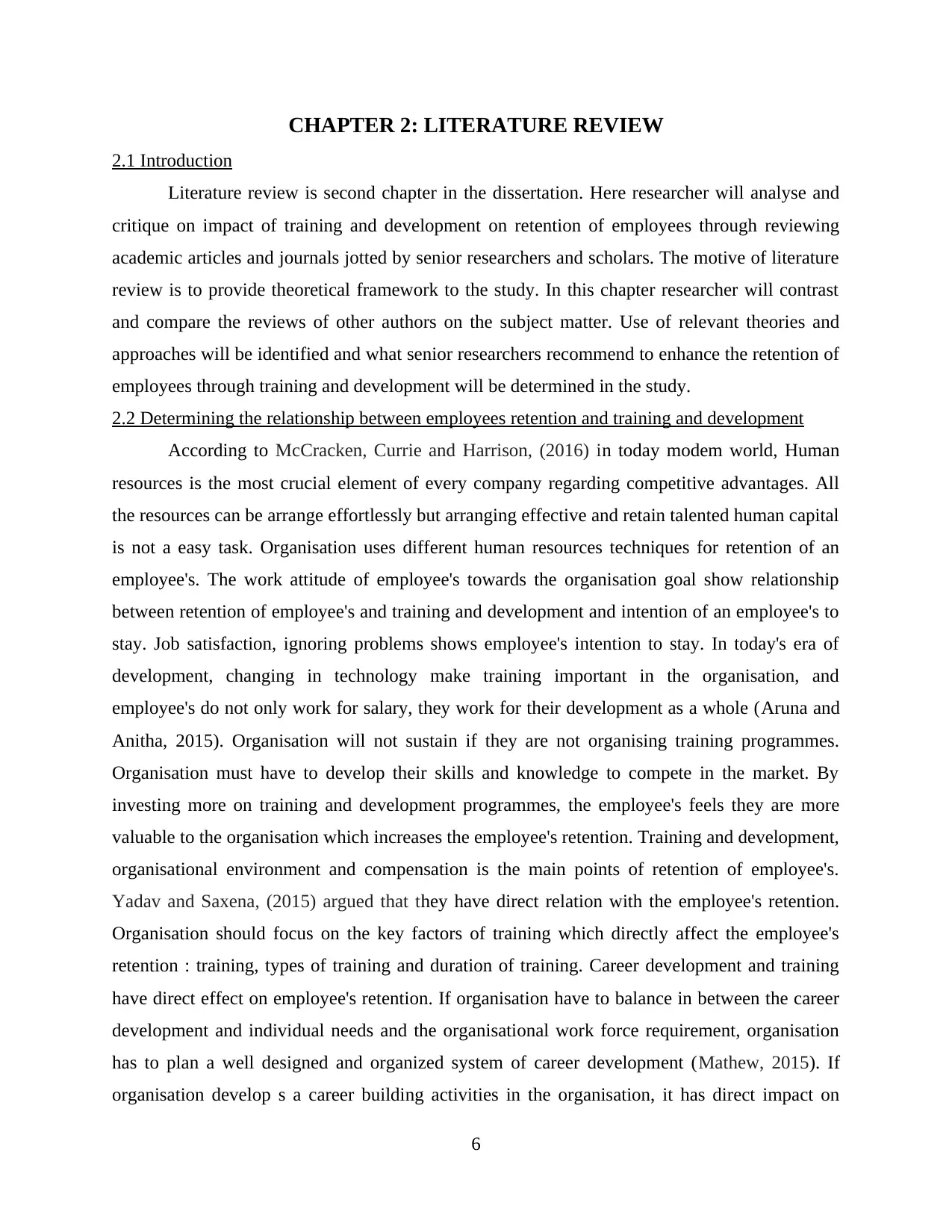
CHAPTER 2: LITERATURE REVIEW
2.1 Introduction
Literature review is second chapter in the dissertation. Here researcher will analyse and
critique on impact of training and development on retention of employees through reviewing
academic articles and journals jotted by senior researchers and scholars. The motive of literature
review is to provide theoretical framework to the study. In this chapter researcher will contrast
and compare the reviews of other authors on the subject matter. Use of relevant theories and
approaches will be identified and what senior researchers recommend to enhance the retention of
employees through training and development will be determined in the study.
2.2 Determining the relationship between employees retention and training and development
According to McCracken, Currie and Harrison, (2016) in today modem world, Human
resources is the most crucial element of every company regarding competitive advantages. All
the resources can be arrange effortlessly but arranging effective and retain talented human capital
is not a easy task. Organisation uses different human resources techniques for retention of an
employee's. The work attitude of employee's towards the organisation goal show relationship
between retention of employee's and training and development and intention of an employee's to
stay. Job satisfaction, ignoring problems shows employee's intention to stay. In today's era of
development, changing in technology make training important in the organisation, and
employee's do not only work for salary, they work for their development as a whole (Aruna and
Anitha, 2015). Organisation will not sustain if they are not organising training programmes.
Organisation must have to develop their skills and knowledge to compete in the market. By
investing more on training and development programmes, the employee's feels they are more
valuable to the organisation which increases the employee's retention. Training and development,
organisational environment and compensation is the main points of retention of employee's.
Yadav and Saxena, (2015) argued that they have direct relation with the employee's retention.
Organisation should focus on the key factors of training which directly affect the employee's
retention : training, types of training and duration of training. Career development and training
have direct effect on employee's retention. If organisation have to balance in between the career
development and individual needs and the organisational work force requirement, organisation
has to plan a well designed and organized system of career development (Mathew, 2015). If
organisation develop s a career building activities in the organisation, it has direct impact on
6
2.1 Introduction
Literature review is second chapter in the dissertation. Here researcher will analyse and
critique on impact of training and development on retention of employees through reviewing
academic articles and journals jotted by senior researchers and scholars. The motive of literature
review is to provide theoretical framework to the study. In this chapter researcher will contrast
and compare the reviews of other authors on the subject matter. Use of relevant theories and
approaches will be identified and what senior researchers recommend to enhance the retention of
employees through training and development will be determined in the study.
2.2 Determining the relationship between employees retention and training and development
According to McCracken, Currie and Harrison, (2016) in today modem world, Human
resources is the most crucial element of every company regarding competitive advantages. All
the resources can be arrange effortlessly but arranging effective and retain talented human capital
is not a easy task. Organisation uses different human resources techniques for retention of an
employee's. The work attitude of employee's towards the organisation goal show relationship
between retention of employee's and training and development and intention of an employee's to
stay. Job satisfaction, ignoring problems shows employee's intention to stay. In today's era of
development, changing in technology make training important in the organisation, and
employee's do not only work for salary, they work for their development as a whole (Aruna and
Anitha, 2015). Organisation will not sustain if they are not organising training programmes.
Organisation must have to develop their skills and knowledge to compete in the market. By
investing more on training and development programmes, the employee's feels they are more
valuable to the organisation which increases the employee's retention. Training and development,
organisational environment and compensation is the main points of retention of employee's.
Yadav and Saxena, (2015) argued that they have direct relation with the employee's retention.
Organisation should focus on the key factors of training which directly affect the employee's
retention : training, types of training and duration of training. Career development and training
have direct effect on employee's retention. If organisation have to balance in between the career
development and individual needs and the organisational work force requirement, organisation
has to plan a well designed and organized system of career development (Mathew, 2015). If
organisation develop s a career building activities in the organisation, it has direct impact on
6
⊘ This is a preview!⊘
Do you want full access?
Subscribe today to unlock all pages.

Trusted by 1+ million students worldwide
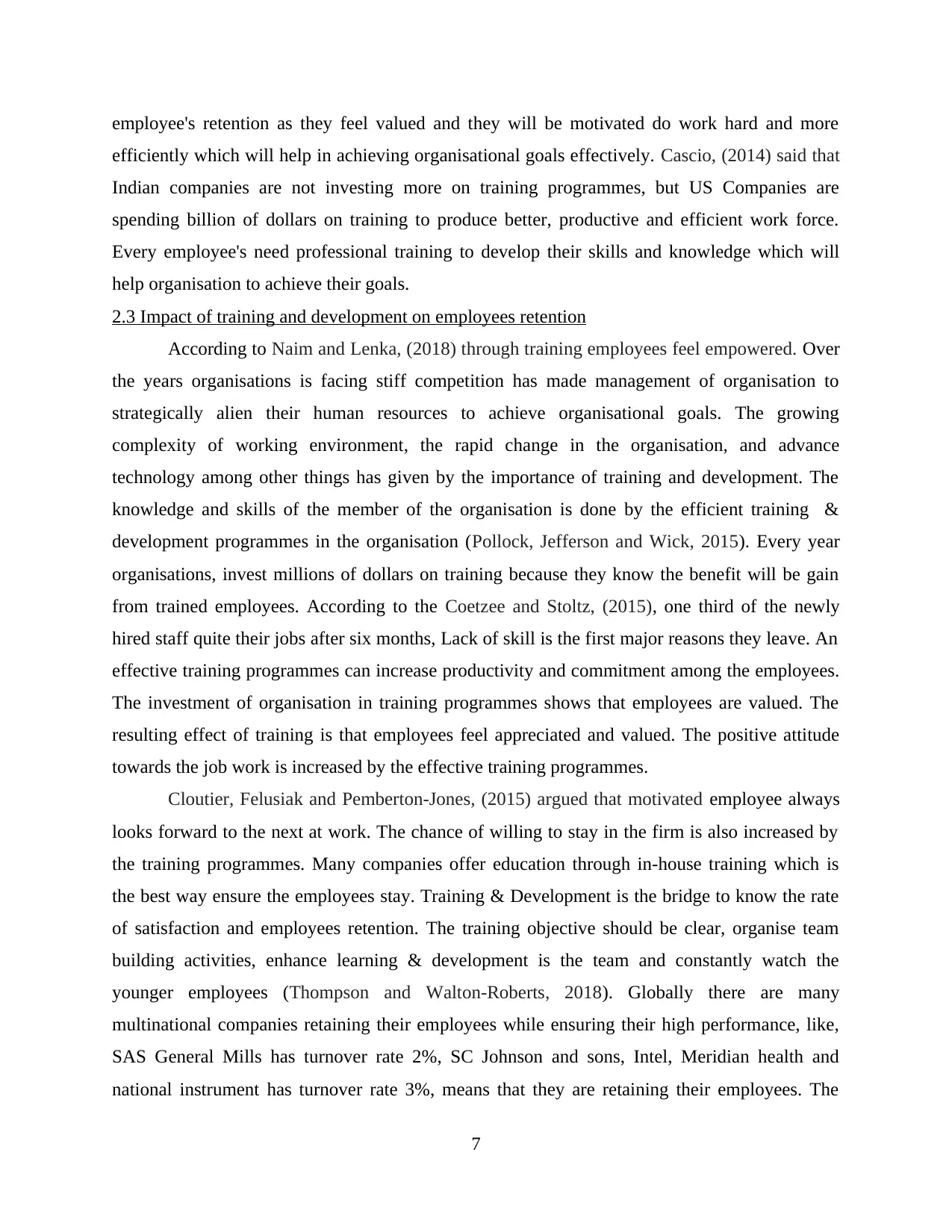
employee's retention as they feel valued and they will be motivated do work hard and more
efficiently which will help in achieving organisational goals effectively. Cascio, (2014) said that
Indian companies are not investing more on training programmes, but US Companies are
spending billion of dollars on training to produce better, productive and efficient work force.
Every employee's need professional training to develop their skills and knowledge which will
help organisation to achieve their goals.
2.3 Impact of training and development on employees retention
According to Naim and Lenka, (2018) through training employees feel empowered. Over
the years organisations is facing stiff competition has made management of organisation to
strategically alien their human resources to achieve organisational goals. The growing
complexity of working environment, the rapid change in the organisation, and advance
technology among other things has given by the importance of training and development. The
knowledge and skills of the member of the organisation is done by the efficient training &
development programmes in the organisation (Pollock, Jefferson and Wick, 2015). Every year
organisations, invest millions of dollars on training because they know the benefit will be gain
from trained employees. According to the Coetzee and Stoltz, (2015), one third of the newly
hired staff quite their jobs after six months, Lack of skill is the first major reasons they leave. An
effective training programmes can increase productivity and commitment among the employees.
The investment of organisation in training programmes shows that employees are valued. The
resulting effect of training is that employees feel appreciated and valued. The positive attitude
towards the job work is increased by the effective training programmes.
Cloutier, Felusiak and Pemberton-Jones, (2015) argued that motivated employee always
looks forward to the next at work. The chance of willing to stay in the firm is also increased by
the training programmes. Many companies offer education through in-house training which is
the best way ensure the employees stay. Training & Development is the bridge to know the rate
of satisfaction and employees retention. The training objective should be clear, organise team
building activities, enhance learning & development is the team and constantly watch the
younger employees (Thompson and Walton-Roberts, 2018). Globally there are many
multinational companies retaining their employees while ensuring their high performance, like,
SAS General Mills has turnover rate 2%, SC Johnson and sons, Intel, Meridian health and
national instrument has turnover rate 3%, means that they are retaining their employees. The
7
efficiently which will help in achieving organisational goals effectively. Cascio, (2014) said that
Indian companies are not investing more on training programmes, but US Companies are
spending billion of dollars on training to produce better, productive and efficient work force.
Every employee's need professional training to develop their skills and knowledge which will
help organisation to achieve their goals.
2.3 Impact of training and development on employees retention
According to Naim and Lenka, (2018) through training employees feel empowered. Over
the years organisations is facing stiff competition has made management of organisation to
strategically alien their human resources to achieve organisational goals. The growing
complexity of working environment, the rapid change in the organisation, and advance
technology among other things has given by the importance of training and development. The
knowledge and skills of the member of the organisation is done by the efficient training &
development programmes in the organisation (Pollock, Jefferson and Wick, 2015). Every year
organisations, invest millions of dollars on training because they know the benefit will be gain
from trained employees. According to the Coetzee and Stoltz, (2015), one third of the newly
hired staff quite their jobs after six months, Lack of skill is the first major reasons they leave. An
effective training programmes can increase productivity and commitment among the employees.
The investment of organisation in training programmes shows that employees are valued. The
resulting effect of training is that employees feel appreciated and valued. The positive attitude
towards the job work is increased by the effective training programmes.
Cloutier, Felusiak and Pemberton-Jones, (2015) argued that motivated employee always
looks forward to the next at work. The chance of willing to stay in the firm is also increased by
the training programmes. Many companies offer education through in-house training which is
the best way ensure the employees stay. Training & Development is the bridge to know the rate
of satisfaction and employees retention. The training objective should be clear, organise team
building activities, enhance learning & development is the team and constantly watch the
younger employees (Thompson and Walton-Roberts, 2018). Globally there are many
multinational companies retaining their employees while ensuring their high performance, like,
SAS General Mills has turnover rate 2%, SC Johnson and sons, Intel, Meridian health and
national instrument has turnover rate 3%, means that they are retaining their employees. The
7
Paraphrase This Document
Need a fresh take? Get an instant paraphrase of this document with our AI Paraphraser
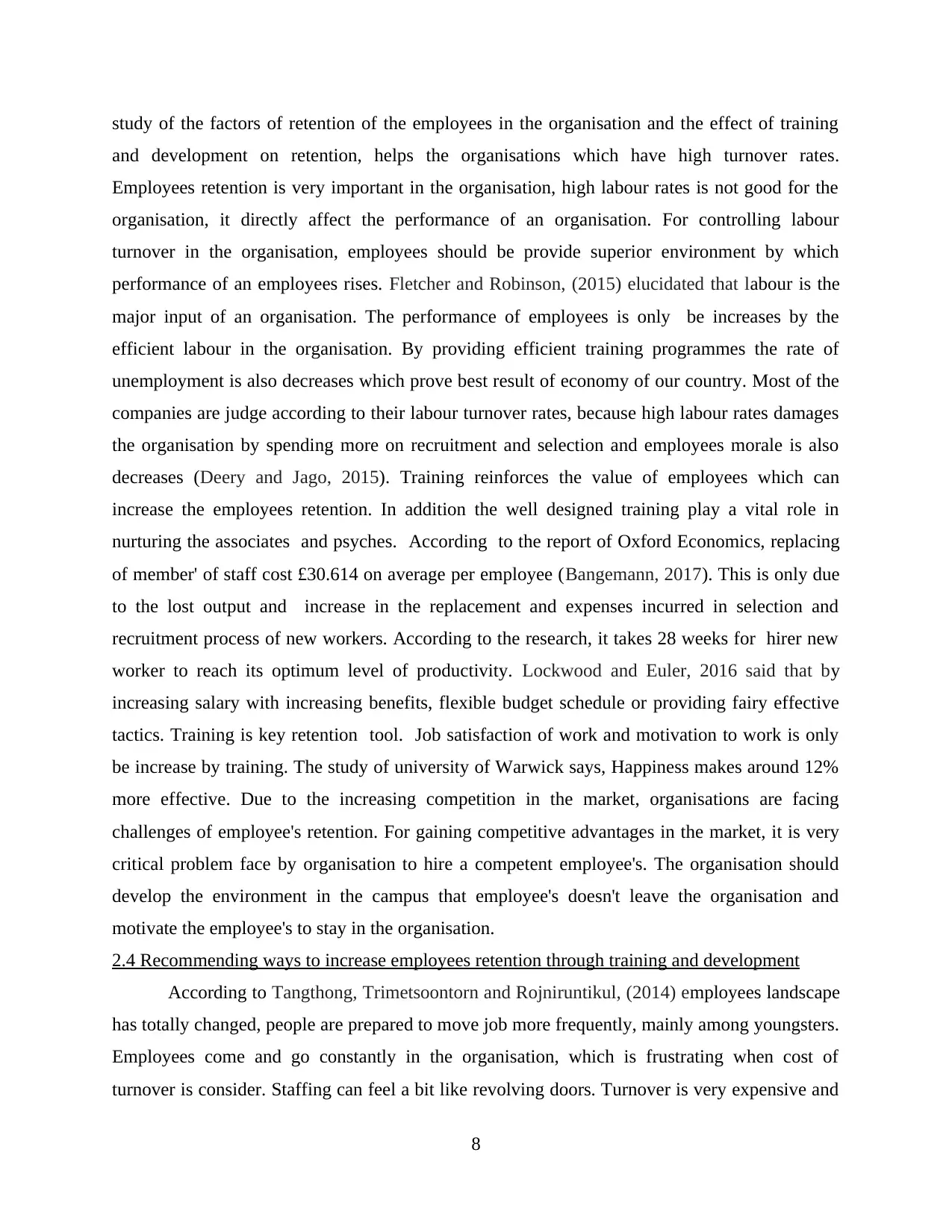
study of the factors of retention of the employees in the organisation and the effect of training
and development on retention, helps the organisations which have high turnover rates.
Employees retention is very important in the organisation, high labour rates is not good for the
organisation, it directly affect the performance of an organisation. For controlling labour
turnover in the organisation, employees should be provide superior environment by which
performance of an employees rises. Fletcher and Robinson, (2015) elucidated that labour is the
major input of an organisation. The performance of employees is only be increases by the
efficient labour in the organisation. By providing efficient training programmes the rate of
unemployment is also decreases which prove best result of economy of our country. Most of the
companies are judge according to their labour turnover rates, because high labour rates damages
the organisation by spending more on recruitment and selection and employees morale is also
decreases (Deery and Jago, 2015). Training reinforces the value of employees which can
increase the employees retention. In addition the well designed training play a vital role in
nurturing the associates and psyches. According to the report of Oxford Economics, replacing
of member' of staff cost £30.614 on average per employee (Bangemann, 2017). This is only due
to the lost output and increase in the replacement and expenses incurred in selection and
recruitment process of new workers. According to the research, it takes 28 weeks for hirer new
worker to reach its optimum level of productivity. Lockwood and Euler, 2016 said that by
increasing salary with increasing benefits, flexible budget schedule or providing fairy effective
tactics. Training is key retention tool. Job satisfaction of work and motivation to work is only
be increase by training. The study of university of Warwick says, Happiness makes around 12%
more effective. Due to the increasing competition in the market, organisations are facing
challenges of employee's retention. For gaining competitive advantages in the market, it is very
critical problem face by organisation to hire a competent employee's. The organisation should
develop the environment in the campus that employee's doesn't leave the organisation and
motivate the employee's to stay in the organisation.
2.4 Recommending ways to increase employees retention through training and development
According to Tangthong, Trimetsoontorn and Rojniruntikul, (2014) employees landscape
has totally changed, people are prepared to move job more frequently, mainly among youngsters.
Employees come and go constantly in the organisation, which is frustrating when cost of
turnover is consider. Staffing can feel a bit like revolving doors. Turnover is very expensive and
8
and development on retention, helps the organisations which have high turnover rates.
Employees retention is very important in the organisation, high labour rates is not good for the
organisation, it directly affect the performance of an organisation. For controlling labour
turnover in the organisation, employees should be provide superior environment by which
performance of an employees rises. Fletcher and Robinson, (2015) elucidated that labour is the
major input of an organisation. The performance of employees is only be increases by the
efficient labour in the organisation. By providing efficient training programmes the rate of
unemployment is also decreases which prove best result of economy of our country. Most of the
companies are judge according to their labour turnover rates, because high labour rates damages
the organisation by spending more on recruitment and selection and employees morale is also
decreases (Deery and Jago, 2015). Training reinforces the value of employees which can
increase the employees retention. In addition the well designed training play a vital role in
nurturing the associates and psyches. According to the report of Oxford Economics, replacing
of member' of staff cost £30.614 on average per employee (Bangemann, 2017). This is only due
to the lost output and increase in the replacement and expenses incurred in selection and
recruitment process of new workers. According to the research, it takes 28 weeks for hirer new
worker to reach its optimum level of productivity. Lockwood and Euler, 2016 said that by
increasing salary with increasing benefits, flexible budget schedule or providing fairy effective
tactics. Training is key retention tool. Job satisfaction of work and motivation to work is only
be increase by training. The study of university of Warwick says, Happiness makes around 12%
more effective. Due to the increasing competition in the market, organisations are facing
challenges of employee's retention. For gaining competitive advantages in the market, it is very
critical problem face by organisation to hire a competent employee's. The organisation should
develop the environment in the campus that employee's doesn't leave the organisation and
motivate the employee's to stay in the organisation.
2.4 Recommending ways to increase employees retention through training and development
According to Tangthong, Trimetsoontorn and Rojniruntikul, (2014) employees landscape
has totally changed, people are prepared to move job more frequently, mainly among youngsters.
Employees come and go constantly in the organisation, which is frustrating when cost of
turnover is consider. Staffing can feel a bit like revolving doors. Turnover is very expensive and
8
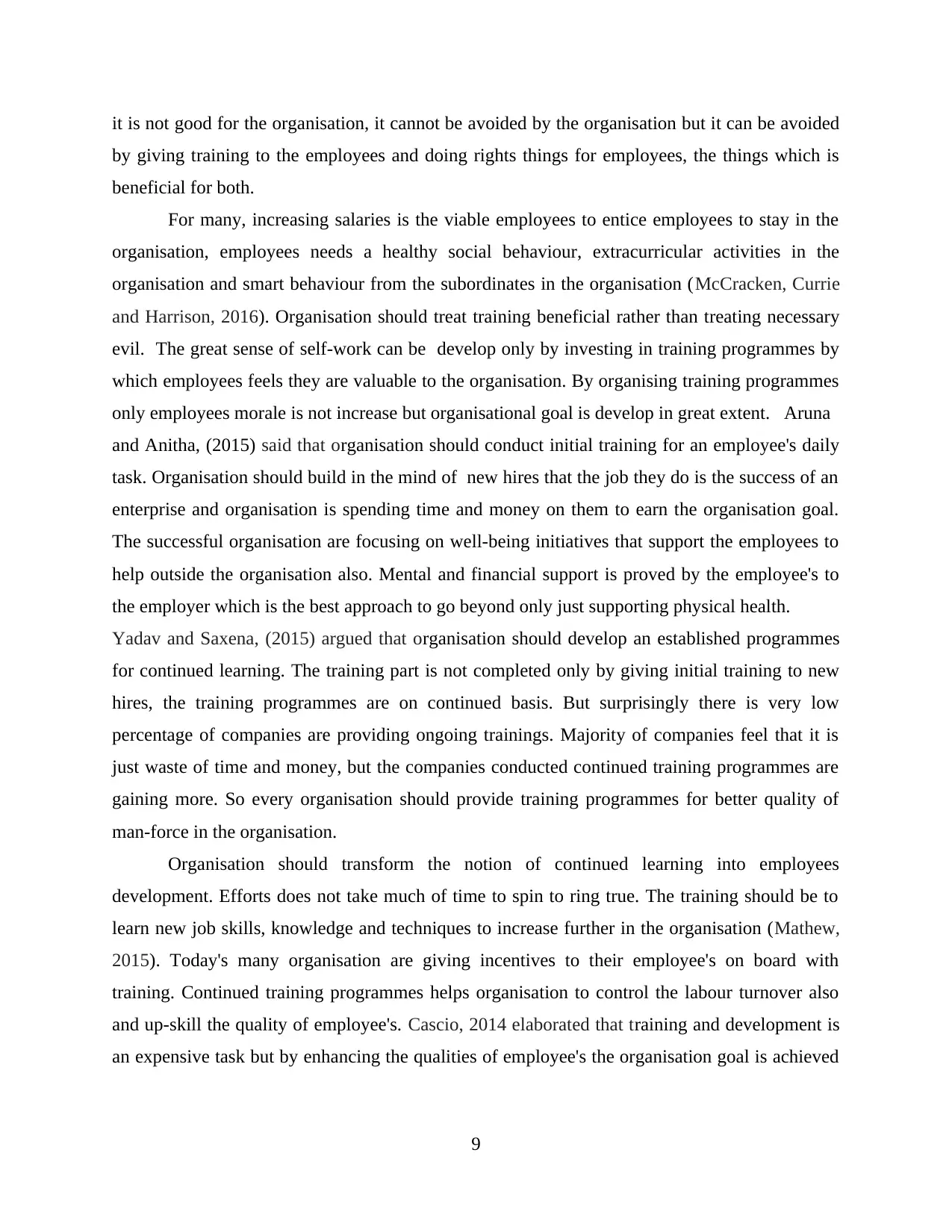
it is not good for the organisation, it cannot be avoided by the organisation but it can be avoided
by giving training to the employees and doing rights things for employees, the things which is
beneficial for both.
For many, increasing salaries is the viable employees to entice employees to stay in the
organisation, employees needs a healthy social behaviour, extracurricular activities in the
organisation and smart behaviour from the subordinates in the organisation (McCracken, Currie
and Harrison, 2016). Organisation should treat training beneficial rather than treating necessary
evil. The great sense of self-work can be develop only by investing in training programmes by
which employees feels they are valuable to the organisation. By organising training programmes
only employees morale is not increase but organisational goal is develop in great extent. Aruna
and Anitha, (2015) said that organisation should conduct initial training for an employee's daily
task. Organisation should build in the mind of new hires that the job they do is the success of an
enterprise and organisation is spending time and money on them to earn the organisation goal.
The successful organisation are focusing on well-being initiatives that support the employees to
help outside the organisation also. Mental and financial support is proved by the employee's to
the employer which is the best approach to go beyond only just supporting physical health.
Yadav and Saxena, (2015) argued that organisation should develop an established programmes
for continued learning. The training part is not completed only by giving initial training to new
hires, the training programmes are on continued basis. But surprisingly there is very low
percentage of companies are providing ongoing trainings. Majority of companies feel that it is
just waste of time and money, but the companies conducted continued training programmes are
gaining more. So every organisation should provide training programmes for better quality of
man-force in the organisation.
Organisation should transform the notion of continued learning into employees
development. Efforts does not take much of time to spin to ring true. The training should be to
learn new job skills, knowledge and techniques to increase further in the organisation (Mathew,
2015). Today's many organisation are giving incentives to their employee's on board with
training. Continued training programmes helps organisation to control the labour turnover also
and up-skill the quality of employee's. Cascio, 2014 elaborated that training and development is
an expensive task but by enhancing the qualities of employee's the organisation goal is achieved
9
by giving training to the employees and doing rights things for employees, the things which is
beneficial for both.
For many, increasing salaries is the viable employees to entice employees to stay in the
organisation, employees needs a healthy social behaviour, extracurricular activities in the
organisation and smart behaviour from the subordinates in the organisation (McCracken, Currie
and Harrison, 2016). Organisation should treat training beneficial rather than treating necessary
evil. The great sense of self-work can be develop only by investing in training programmes by
which employees feels they are valuable to the organisation. By organising training programmes
only employees morale is not increase but organisational goal is develop in great extent. Aruna
and Anitha, (2015) said that organisation should conduct initial training for an employee's daily
task. Organisation should build in the mind of new hires that the job they do is the success of an
enterprise and organisation is spending time and money on them to earn the organisation goal.
The successful organisation are focusing on well-being initiatives that support the employees to
help outside the organisation also. Mental and financial support is proved by the employee's to
the employer which is the best approach to go beyond only just supporting physical health.
Yadav and Saxena, (2015) argued that organisation should develop an established programmes
for continued learning. The training part is not completed only by giving initial training to new
hires, the training programmes are on continued basis. But surprisingly there is very low
percentage of companies are providing ongoing trainings. Majority of companies feel that it is
just waste of time and money, but the companies conducted continued training programmes are
gaining more. So every organisation should provide training programmes for better quality of
man-force in the organisation.
Organisation should transform the notion of continued learning into employees
development. Efforts does not take much of time to spin to ring true. The training should be to
learn new job skills, knowledge and techniques to increase further in the organisation (Mathew,
2015). Today's many organisation are giving incentives to their employee's on board with
training. Continued training programmes helps organisation to control the labour turnover also
and up-skill the quality of employee's. Cascio, 2014 elaborated that training and development is
an expensive task but by enhancing the qualities of employee's the organisation goal is achieved
9
⊘ This is a preview!⊘
Do you want full access?
Subscribe today to unlock all pages.

Trusted by 1+ million students worldwide
1 out of 38
Related Documents
Your All-in-One AI-Powered Toolkit for Academic Success.
+13062052269
info@desklib.com
Available 24*7 on WhatsApp / Email
![[object Object]](/_next/static/media/star-bottom.7253800d.svg)
Unlock your academic potential
Copyright © 2020–2025 A2Z Services. All Rights Reserved. Developed and managed by ZUCOL.





